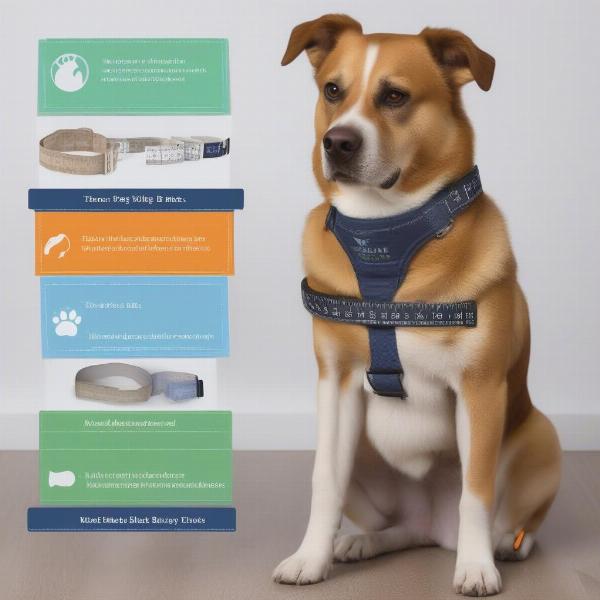Male dog belly bands are a helpful tool for managing urinary incontinence, marking behaviors, and even anxieties in male dogs. Whether your furry friend is a senior experiencing age-related incontinence, a young pup still learning house-training, or simply an enthusiastic marker, a belly band can offer a practical solution while maintaining your dog’s comfort and dignity. Understanding how to choose the right belly band, use it correctly, and care for it properly is crucial for maximizing its effectiveness and ensuring your dog’s well-being.
Choosing the Right Male Dog Belly Band
Selecting the appropriate belly band for your male dog depends on several factors, including his size, the severity of his incontinence, and his activity level. Measuring your dog’s waist accurately is the first step. A snug but not constricting fit is essential for both comfort and effectiveness. Consider the absorbency of the band. For dogs with light leakage, a thinner band with a moderate absorbency layer may suffice. However, for heavier incontinence, you’ll need a band with a thicker, more absorbent core.  Choosing a belly band for a male dog
Choosing a belly band for a male dog
Different materials offer varying levels of comfort and durability. Washable, reusable bands are a cost-effective and eco-friendly option. Disposable bands offer convenience but generate more waste. Consider your lifestyle and budget when making this decision. Finally, think about your dog’s activity level. Active dogs will benefit from bands with secure closures and a comfortable, non-restrictive design.
Using and Caring for Male Dog Belly Bands
Once you’ve chosen the right belly band, proper usage and care are essential. Ensure the band fits snugly but doesn’t restrict movement or breathing. The absorbent pad should be positioned to cover the penis. Regularly check the band for wetness and change it as needed, typically every few hours or as soon as it becomes soiled. For washable bands, follow the manufacturer’s instructions for washing and drying.
For dogs experiencing anxiety-related marking, introducing the belly band gradually and associating it with positive reinforcement can help create a positive association. Remember, a belly band is not a substitute for addressing the underlying cause of incontinence or marking. Consult with your veterinarian to rule out any medical conditions and discuss potential behavioral modifications.
Addressing Common Concerns about Belly Bands
Many dog owners have questions about the use of belly bands. Will my dog be comfortable wearing a belly band? With the right fit and introduction, most dogs adjust quickly and comfortably to wearing a belly band. belly band for male dogs
Are belly bands a long-term solution? Belly bands can be a helpful management tool, both short-term and long-term, depending on the underlying cause of the issue. They offer a practical solution while you work with your veterinarian to address any medical concerns or implement behavioral training. Can belly bands be used for excitable urination? Yes, belly bands can be beneficial for managing excitable urination, providing a sense of security and preventing leakage during moments of excitement.
“When introducing a belly band, patience and positive reinforcement are key. Make it a positive experience for your dog, and they’ll adapt quickly,” says Dr. Emily Carter, a veterinary behaviorist.
Benefits of Using Male Dog Belly Bands
male dog belly band offer a range of benefits: Maintaining hygiene in your home Reducing stress for both you and your dog Providing a sense of security and confidence for your dog Allowing your dog to continue participating in family activities Protecting furniture and other belongings from urine marking
Conclusion
Male dog belly bands are a valuable tool for managing urinary incontinence and marking behaviors. male dog wraps belly bands can significantly improve your dog’s quality of life and make living with these challenges much easier. By understanding the different types of belly bands available, choosing the right one for your dog, and using it correctly, you can provide your furry friend with comfort, confidence, and a cleaner, healthier home environment.
FAQ
- How often should I change my dog’s belly band? As soon as it becomes soiled or wet.
- Can my dog wear a belly band all the time? It’s best to give your dog breaks from wearing the band to avoid skin irritation.
- Are belly bands cruel? No, when used correctly, they are a humane and helpful tool.
- How do I measure my dog for a belly band? Measure around his waist, just in front of his hind legs.
- Can I use a human incontinence product on my dog? No, dog belly bands are specifically designed for canine anatomy and needs.
- What if my dog keeps trying to remove the belly band? Ensure a proper fit and use positive reinforcement.
- Where can I buy male dog belly bands? incontinence supplies for dogs are available at pet stores, veterinary clinics, and online retailers.
About ILM Dog
ILM Dog is your trusted international resource for expert dog care advice, offering practical guidance on breeds, health, training, nutrition, grooming, and more. We provide evidence-based information for dog owners of all experience levels, from puppy care to senior dog support, and everything in between. We also offer resources for traveling with your dog and finding the best products and accessories. Connect with us for personalized advice: [email protected] | +44 20-3965-8624.